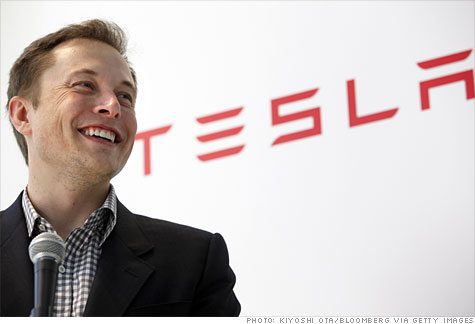Elon Musk, the maverick CEO of Tesla Motors Inc., is not to be taken lightly. First, he came up with an elegant electric vehicle that performs as good as it looks, while offering an extended range, something other all-electric vehicles could only talk about. Now, he says, time has arrived to go mainstream, with a version that offers extended range but with a price tag that may appeal to the ordinary folks, not just the rich, who have been his clients up to now.
The biggest obstacle is that there are not enough batteries for Tesla to ramp up production. The second is that today’s batteries, when you can find them, are pricey for the amount of energy they store. Now that Tesla feels confident that if it can build more, consumers will buy them, it has decided to get into battery manufacturing business, and not in a haphazard way, but by building what is referred to as a $5 billion mega-factory.
 Following the announcement, Mr. Musk, who is worth billions as stocks of his company continue to defy all laws of logic and gravity (graph on page 15), said, “Shifting to greater use of solar and wind power will challenge utility companies.” In case his message did not register, he added, the shift will bring, “some amount of strife for the existing utilities, especially for those invested more heavily in fossil fuels.”
Following the announcement, Mr. Musk, who is worth billions as stocks of his company continue to defy all laws of logic and gravity (graph on page 15), said, “Shifting to greater use of solar and wind power will challenge utility companies.” In case his message did not register, he added, the shift will bring, “some amount of strife for the existing utilities, especially for those invested more heavily in fossil fuels.”
Speaking before a receptive, if nervous, audience at the California Public Utilities Commission (CPUC), the state’s regulator, Musk said Tesla is “working to create stationary battery packs that last long, are super safe and are compact.”
His cousin, SolarCity’s CEO Lyndon Rive, went even further by predicting that “There is no doubt storage will become cost effective and deliver electricity with storage at night.” As if that was not enough to shock and awe, Rive added that utilities in California and elsewhere, who are resisting change, are merely delaying the inevitable.
The “Thought Leaders” session at CPUC, which normally draws 50 attendees or so, filled the largest auditorium and 2 adjacent rooms as hordes of people, no doubt including many job seekers with resumes in hand, flocked to hear Musk, a high-tech celebrity worthy of Hollywood paparazzi.
Musk and Rive, of course, can say what they want and get away with it. Both their companies are on a rapid growth path, pushing new technologies, enjoying increased sales, and facing declining costs. The utility industry, by contrast, is facing tepid or no growth, for the most part relies on technologies that have been around for decades if not longer, and facing increasing costs, especially in upgrading the aging network, the grid. While the average age of Tesla and SolarCity’s workforce is under 30, utilities are mostly dealing with an aging workforce ready for retirement. Utility stocks are stable at best, if the companies are well-managed while Tesla’s stocks keep on rising. The contrast between the old and the new is inescapable.
As CEO of a major solar PV company, Rive was critical of utilities, who are “taking months to connect residential solar panels to their systems” accusing them of playing games, “because they profit from the current system.”
“When you have a game- changing technology, those in the game don’t want to change,” Rive said. “They like the existing game, the sole source, cost-plus model.”
Rive noted that it now takes 8 months for utilities in California to connect a SolarCity PV customer with an energy storage system to the grid.
As reported in the February 2014 issue of this newsletter, Hawaiian Electric Company (HECO) placed a temporary moratorium on new solar PV connections while trying to figure out how to deal with the surge of new installations.
Tesla’s new battery factory, if all goes according to plan, could make it easier for customers to store their excess generation during sunny periods for later use, whether in their Tesla cars or in a storage device in the garage. Musk, who is SolarCity’s chairman and the largest shareholder, has been offering Tesla batteries to selected rooftop solar customers in parts of California and New England. Once battery production soars and prices plunge, as expected, more PV customers can be fitted with storage.
Tesla’s stock shot to $352.54 on 19 March 2014.
Perry Sioshansi is president of Menlo Energy Economics, a consultancy based in San Francisco, CA and editor/publisher of EEnergy Informer, a monthly newsletter with international circulation. He can be reached at [email protected]








